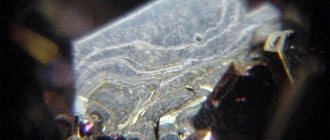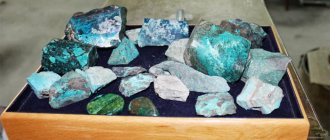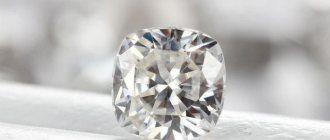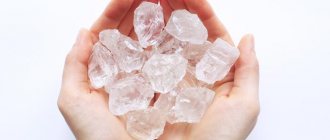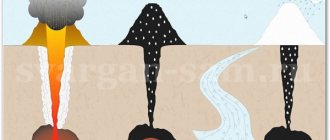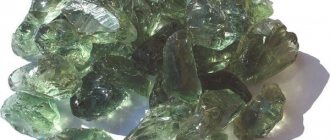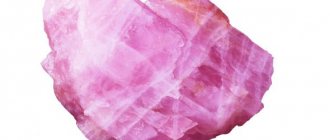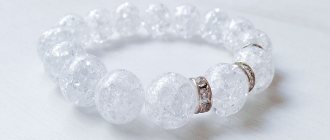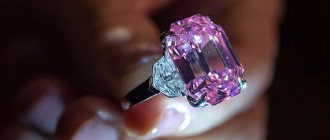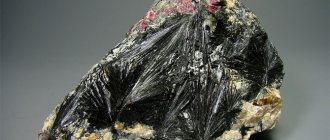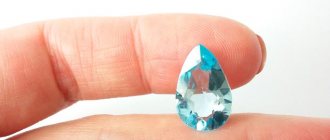Carborundum (silicon carbide) is a dense material of varying degrees of transparency, obtained by combining sand with coal by melting. Black specimens resemble anthracite in appearance, but there are other shades. In bright light, the mineral shimmers with rainbow colors, forming various patterns on the surface.
Mineral – Carborundum
Due to its numerous beneficial properties, carborundum is used not only in the jewelry industry, but also in electronics, steelmaking, etc. In addition, the mineral has magical and healing effects.
History and origin
They learned how to produce carborundum synthetically since the middle of the 19th century, but it was patented only in 1893. Until 2016, the USA was the manufacturer of artificial stone, but today China is recognized as its main supplier to the world market. Currently, about 250 modifications of carborundum of different colors and shades are produced. Stones used in the jewelry industry are covered with a special film, which allows the crystal to look like a real diamond.
In nature, this crystal is distributed in very small quantities, so it is almost impossible to find large deposits.
Important! The process of producing factory stone takes place on the latest technological equipment, where specialists carefully control its growth stage. This allows you to obtain an almost perfect mineral (without possible flaws).
Carborundum: what is it?
In fact, the stone, created at the behest of heaven, is of natural origin, but is found there in very minute quantities. Carborundum, in the language of scientists called silicon carbide, has the appearance of colorless, iridescent crystals with a diamond luster.
So, carborundum belongs to the class of semiconductor binary chemical compound, consists of silicon and carbon, denoted by the chemical formula SiC.
This material is very refractory and durable. Compared to moissanite, even the diamond itself rests quietly on the sidelines. In terms of strength, carborundum is second only to diamond and borazone.
Natural origin of carborundum
A unique, amazingly beautiful fusion of silicon and carbon gave birth to a brilliant mineral with a slight tint of diamond radiance, this is a spectacle of the Gods that touches the soul with its unyielding fragility, amazing tenderness and angelic depth of beauty.
In nature, handfuls of small pebbles - silicon carbide - are common in very small quantities, so large deposits could not be found. Why it failed is the mystery of the century, over which all scientists are scratching their heads.
Artificial origin of carborundum
Jewelry art has always aroused interest among all segments of the population. The pure, iridescent, naive shine of jewelry excited the heart, making it beat a hundred times faster; people, like crows, were drawn to what sparkles and sparkles.
And in the 20th century, to the happiness of the people, the most brilliant stone on the planet appeared - moissanite, which by nature is very beautiful in itself, but the beauty of the improved stone is simply stunning!
Artificial moissanite is a one-of-a-kind combination of true art and science. Currently, only one company in the world, called Charles & Colvard, specializes in carborundum processing.
The entire process takes place using the latest high-tech equipment; specialists carefully monitor the stage of stone growth, so there is not a single flaw in the structure of this mineral! As a result, a new product was released, produced using patented technology, this new product breaks all records in beauty, it is a mineral of the highest quality, which is imprinted in the hearts of millions of people for a long time.
The legendary moissanite with its deep play of light on its facets is one of the most noble minerals in the jewelry collection; moissanite shimmers with the purest shades in the world, thanks to this its unique inner beauty is achieved, incomparable to the beauty of any other stone in the world.
Deep connoisseurs of sophistication and aesthetic beauty - jewelers and collectors - speak of the mineral as the “crown of creation”! This stone is as fragile, pure and sacred as it can be! This is a million dollar stone!
Physico-chemical properties of stone
Chemical formula: SiC
State: crystals, druses or crystalline powders from transparent white, yellow, green or dark blue to black, depending on purity, dispersity, allotropic and polytypic modifications.
Melting point: 2830°C
Silicon carbide
:
- Density 3.05 g/cm³
- Composition: 93% silicon carbide
- Ultimate bending strength 320…350 MPa
- Compressive strength 2300 MPa
- Elastic modulus 380 GPa
- Hardness 87…92 HRC
- Crack resistance within 3.5 - 4.5 MPa m1/2,
- Thermal conductivity coefficient at 100 °C, 140-200 W/(m K)
- Coeff. thermal expansion at 20-1000 °C, 3.5…4.0 K−1⋅10−6
- Fracture toughness 3.5 MPa m1/2
Also read: Ophite - a stone that absorbs negative energy
Self-bonded silicon carbide
:
- Density 3.1 g/cm³
- Composition: 99% silicon carbide
- Ultimate bending strength 350-450 MPa
- Compressive strength 2500 MPa
- Elastic modulus 390–420 GPa
- Hardness 90…95 HRC
- Crack resistance within 4 - 5 MPa m1/2,
- Thermal conductivity coefficient at 100 °C, 80 - 130 W/(m K)
- Coeff. thermal expansion at 20-1000 °C, 2.8…4 K−1⋅10−6
- Fracture toughness 5 MPa m1/2
VK6OM
:
- Density 14.8 g/cm³
- Composition Tungsten carbide
- Ultimate bending strength 1700…1900 MPa
- Compressive strength 3500 MPa
- Elastic modulus 550 GPa
- Hardness 90 HRA
- Crack resistance within 8-25 MPa m1/2,
- Thermal conductivity coefficient at 100 °C, 75…85 W/(m K)
- Coeff. thermal expansion at 20-1000 °C, 4.5 K−1⋅10−6
- Fracture toughness 10…15 MPa m1/2
Siliconized graphite SG-T
:
- Density 2.6 g/cm³
- Composition: 50% silicon carbide
- Ultimate bending strength 90…110 MPa
- Ultimate compressive strength 300…320 MPa
- Elastic modulus 95 GPa
- Hardness 50…70 HRC
- Crack resistance within 2-3 MPa m1/2,
- Thermal conductivity coefficient at 10 °C, 100…115 W/(m K)
- Coeff. thermal expansion at 20-1000 °C, 4.6 K−1⋅10−6
- Fracture toughness 3…4 MPa m1/2
Chemical properties of carbon
Carbon is capable of forming several allotropic modifications. These are diamond (the most inert allotropic modification), graphite, fullerene and carbyne. Charcoal and soot are amorphous carbon. Carbon in this state does not have an ordered structure and actually consists of tiny fragments of graphite layers. Amorphous carbon treated with hot water steam is called activated carbon. 1 gram of activated carbon, due to the presence of many pores in it, has a total surface of more than three hundred square meters! Due to its ability to absorb various substances, activated carbon is widely used as a filter filler, as well as an enterosorbent for various types of poisoning.
From a chemical point of view, amorphous carbon is its most active form, graphite exhibits moderate activity, and diamond is an extremely inert substance. For this reason, the chemical properties of carbon discussed below should primarily be attributed to amorphous carbon.
Reducing properties of carbon
As a reducing agent, carbon reacts with non-metals such as oxygen, halogens, and sulfur.
Depending on the excess or lack of oxygen during coal combustion, the formation of carbon monoxide CO or carbon dioxide CO2 is possible:
When carbon reacts with fluorine, carbon tetrafluoride is formed:
When carbon is heated with sulfur, carbon disulfide CS2 is formed:
Carbon is capable of reducing metals after aluminum in the activity series from their oxides. For example:
Carbon also reacts with oxides of active metals, but in this case, as a rule, it is not the reduction of the metal that is observed, but the formation of its carbide:
Interaction of carbon with non-metal oxides
Carbon enters into a coproportionation reaction with carbon dioxide CO2:
One of the most important processes from an industrial point of view is the so-called steam reforming of coal. The process is carried out by passing water vapor through hot coal. The following reaction occurs:
At high temperatures, carbon is capable of reducing even such an inert compound as silicon dioxide. In this case, depending on the conditions, the formation of silicon or silicon carbide (carborundum) is possible:
Also, carbon as a reducing agent reacts with oxidizing acids, in particular concentrated sulfuric and nitric acids:
Oxidative properties of carbon
The chemical element carbon is not highly electronegative, so the simple substances it forms rarely exhibit oxidizing properties towards other non-metals.
An example of such reactions is the interaction of amorphous carbon with hydrogen when heated in the presence of a catalyst:
and also with silicon at a temperature of 1200-1300 oC:
Carbon exhibits oxidizing properties in relation to metals. Carbon is capable of reacting with active metals and some intermediate activity metals. Reactions occur when heated:
Active metal carbides are hydrolyzed by water:
as well as solutions of non-oxidizing acids:
In this case, hydrocarbons are formed containing carbon in the same oxidation state as in the original carbide.
Areas of application
Carborundum is used in many areas of industry because it is highly resistant to destruction and extreme temperatures. Here are the main areas of its application:
- As a structural material, stone is used to make brakes for racing cars, panels and slabs, elements for military equipment, abrasive attachments, etc.
- In electronics, semiconductor devices (thyristors), ultra-fast diodes, etc. are made from silicon carbide.
- In steelmaking - it is used as fuel for the production of steel, as well as in the correction of temperature conditions in the production of metal products.
- In nuclear energy, the mineral is used to make a coating for nuclear fuel elements, added to grinding pastes, etc.
- In jewelry - it is used as moissanite (because it resembles a diamond in appearance), it is used to decorate rings, necklaces, chokers, bracelets, earrings, brooches, etc.
Also read: Jarosite - a natural pigment
Interesting fact! Moissanite is often used to imitate a diamond, selling products to the buyer at the cost of an expensive gemstone (since it is difficult to distinguish one from the other with the naked eye).
Structure and properties
In nature, there are more than 250 crystalline forms of carborundum, which can vary in properties and colors. The crystal lattice of carborundum has no analogues in the world; it is unique, like the stone itself.
But all types of carborundum have a number of qualities in common, namely, resistance to acids, increased chemical and thermal stability, and the ability to withstand high temperatures up to 1500 degrees Celsius.
Moissanite has exceptional beauty and transparency; no other jewelry on Earth can overshadow its sparkling brilliance! Even a diamond jingles nervously aside in comparison.
One of the most useful and necessary properties of carborundum for humanity is its high abrasion resistance , which is why cases of using carborundum in the construction of metro stations and roadside stations have become more frequent.
Every year, every month, every hour, every minute and second, millions of soles are scraped across panels and slabs containing fine-crystalline carborundum.
The most important properties of carborundum include an increased level of heat resistance and amazing resistance to acids.
Medicinal properties
In addition to practical use in various industries, the mineral has medicinal properties. Here are some of them:
- Relieves phobias and prolonged depression.
- Calms nerves and improves sleep.
- Normalizes metabolism.
- Improves the condition of the gastrointestinal tract in case of gastritis or ulcers.
- Restores liver function, eliminating hepatitis and early stage cirrhosis.
- When worn continuously, it eliminates headaches and joint pain.
- Normalizes hormonal levels.
- Improves hematopoiesis, and is especially useful for anemia.
- Strengthens the immune system.
Links
- Kelly, Jim.
A brief history of SiC: [arch. 01/19/2008] // Jim Kelly's filing cabinet. - Department of Chemistry, University College London, 2005. - September 24. — Date of access: 06/23/2020. - Silicon carbide: technology, properties, application / Ed. Belyaeva A. E., Konakova R. V. - Kharkov: ISMA, 2010. - 532 p. — ISBN 978-966-02-5445-9
- Digonsky S.V.
Gas-phase processes of synthesis and sintering of refractory substances. - M.: GEOS, 2013. - 462 p.
| Dictionaries and encyclopedias |
|
| In bibliographic catalogs |
|
Magic properties
Carborundum has the following magical properties:
- Improves material well-being and attracts money to its owner.
- Helps overcome fear on the way to the goal, sweeping away all obstacles along the way.
- Helps its owner gain sexual attraction for the opposite sex.
- Improves memory and intellectual abilities.
- Protects from external negativity (damage, evil eye, curse).
Be careful! It is not recommended to carry carborundum with you at all times, as this can lead to nervous agitation or insomnia.
Magical and healing properties of carborundum
This stone is obtained under artificially created conditions, but carborundum contains natural raw materials. Therefore, many esotericists attribute healing energy to it, which can influence human life and health.
How magical properties manifest themselves:
- The stone symbolizes prosperity and wealth, and also helps to make the atmosphere in the home more harmonious.
- It personifies hard work, energy, activity, and therefore helps to cope with suspiciousness and fears that usually arise in a person on the way to achieving a goal.
- Blue carborundum helps increase intelligence and make a person more attractive to members of the opposite sex.
- If a person has secret dreams, the energy of the stone will definitely help to realize them.
- Gives reliable protection from the harmful influence of unfriendly people: helps ward off damage and the evil eye.
- Gives a charge of positive emotions, which is important for those who are depressed. Gives vigor and energy.
- The energy of the stone brings financial success and prosperity in business.
Carborundum is also credited with medicinal properties.
Primarily useful for nervous disorders: insomnia, phobias, hallucinations, panic attacks, attacks of aggression. Helps to find spiritual harmony and get rid of depressing thoughts. Effectively relieves headaches. The stone also helps with weakened immunity. Carborundum is useful for metabolic disorders in the body. Treats gastritis and ulcerative diseases of the gastrointestinal tract. Liver cirrhosis and hepatitis are also indications for wearing carborundum products. The stone is not used in astrology.
Stone cost
Carborundum has a relatively low cost, so everyone can afford it. Here are its approximate prices (measured in Russian rubles):
- Raw nuggets (crystals) - can be purchased within 1000 rubles.
- As jewelry (pendants, rings, necklaces, bracelets, etc.) - 4000-15000.
Stone earrings
Caring for your jewelry
The artificial mineral material is quite resistant to external damage, high temperatures and acids, so caring for it is easy and simple. In order for moissanite to serve “faithfully and truly” for a long time, it is enough to comply with 2 conditions:
- Store the stone in a box (you can “company” other jewelry).
- If necessary, clean with any detergents, with the exception of abrasives (since the microfilm applied to the surface of the stone may be damaged).
Compatibility with zodiac signs
(“+++” – the stone fits perfectly, “+” – can be worn, “-” – is strictly contraindicated):
| Zodiac sign | Compatibility |
| Aries | +++ |
| Taurus | + |
| Twins | +++ |
| Cancer | + |
| a lion | +++ |
| Virgo | + |
| Scales | +++ |
| Scorpion | + |
| Sagittarius | +++ |
| Capricorn | + |
| Aquarius | +++ |
| Fish | + |
The mineral suits all zodiac signs without exception. But it will bring the greatest benefit to people of the elements of Fire (Leo, Sagittarius, Aries) and Air (Aquarius, Gemini, Libra).
Is this stone right for you?
Interesting things about the stone
Several interesting facts about the stone have been circulated:
- Near the Vesuvius volcano (located in Italy), solidified lava is sold to tourists as carborundum.
- Moissanite is often called a “space” stone, because it is present in greater quantities in space than on Earth.
- Scientists suggest that natural silicon carbide first appeared outside the solar system. They came to these conclusions after studying the Murchison meteorite.
- The mineral was first discovered by the French scientist Henri Moissan. Hence its self-explanatory name.
Application and technical characteristics
Stone is used in almost all sectors of human life. Due to the stability and strength of this mineral, it is necessary in construction. It is suitable for interior and exterior decoration of stone premises, producing good interior items. Carborundum is part of the road surface. It is used in the construction of cars, astronomy and electronics. The stone is used in brakes for sports cars and body parts of armored vehicles, giving them strength and endurance. It is used to make grinding powders needed in electronics and metallurgy. This mineral is also irreplaceable in jewelry. It is used in the production of luxury jewelry and other valuables. Due to the properties of a semiconductor, it is used as a catalyst; it is present in LEDs and lasers.
